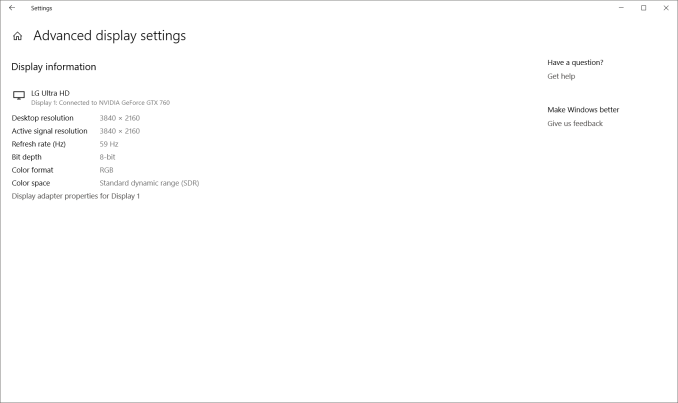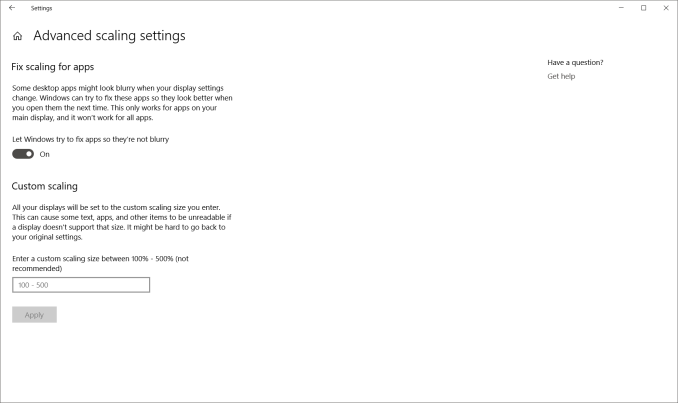The Windows 10 April Update (1803): The Littlest Big Update
by Brett Howse on May 25, 2018 8:00 AM EST- Posted in
- Software
- Operating Systems
- Windows
- Microsoft
- Windows 10
Display Updates: HDR and High DPI
HDR Updates
High Dynamic Range (HDR) is definitely the new buzzword in the display industry, with displays that offer a wider range of brightness levels. There’s more steps between brightness levels, and proper HDR monitors should offer a much higher maximum brightness level as well.
The requirements for HDR haven’t changed very much since the Fall Creators Update, but there’s a couple of small tweaks. If you’re using a laptop, the device manufacturer has to provide a panel that is at least 300 nits or more, but new for the April Update is that the panel is also required to be at least 1920x1080. The laptop will also need to have an integrated GPU that supports PlayReady hardware DRM for protected HDR content, and have the codecs installed for 10-bit video decoding, which is only the latest CPUs. Since you can’t buy a laptop and add HDR, this is all something that has to be handled by the OEM of course.
For external displays, the system and display both need to support HDMI 2.0 or DisplayPort 1.4, as well as HDR10. There’s no support for DolbyVision in Windows yet.
 Your display HDR support is shown here
Your display HDR support is shown here
The GPU must support PlayReady 3.0 hardware DROM for protected HDR content, which is right now a short list of GPUs: AMD Radeon RX 400 or higher, Intel UHD 600 series iGPUs, or NVIDIA GeForce 1000 series cards. All of these cards support the 10-bit video decoding required for HDR.
The PC must have the HEVC or VP9 codec installed as well, and the latest drivers should be used.
HDR is currently only supported for video playback. We’re not yet at a point where the entire OS can be done in HDR.
If you’re using a laptop, Microsoft now has an HDR calibration tool built-in which lets you adjust balance between detail in the dark part of a scene with the brighter parts, and to set if you want HDR to increase display brightness when on battery or not.
High DPI Updates
Using apps created for 96 DPI displays on displays with 200, 300, or more DPI can be a challenge, and over the years, improvements have been made in Windows to better support this. UWP was a possible solution, but with its limited traction it didn’t turn out to be much of a solution, so Microsoft has been fixing both built-in apps to work better on higher resolution displays, as well as fixing issues with using different DPI levels on different displays connected to the system, which is a big issue if you have a new laptop with a high-resolution display, and also dock it with an older 96 DPI monitor.
Microsoft has no real solution to this issue, other than have a dev update their app for HiDPI, but with the April Update Windows 10 will now prompt you to automatically try and fix an app if it think it’s opened with blurry text. You’ll get a notification asking if you’d like to try and fix it, and you can say yes. Then close the app, and hopefully it’s fixed.
Windows was built around 96 DPI as a staple, and with the legacy baggage, this issue will likely never be completely resolved, but luckily most apps work fine now. Some are not perfect, but most of the big name apps now work correctly, which isn’t something you could have said even a couple of years ago.












161 Comments
View All Comments
nico_mach - Friday, May 25, 2018 - link
They pretty much did? These are the best, most useful implementations of Linux on Windows I've seen, and they're only lacking server versions.If you mean, why don't they ship linux? Well, they kind of do on Azure. There's no real reason to do so as a consumer facing OS, unless you're suggesting Windows EdgeOS? Which is very clearly crossing the line into why-bother territory.
PeachNCream - Tuesday, May 29, 2018 - link
There's no value in running something other than a *nix kernel at this point. If they want to keep costs low in the OS development department, then its probably as good a time as any to make the transition. The open source community and Microsoft could further mutually benefit from working together as would software compatibility and cross-platform functionality. All of that can be relatively hidden from the end user by the OS UI so aside from the one-time cost of conversion, a cost they could absorb into pushing out Windows 11 -- something that they'll eventually have to do anyway given predominant market forces, I think staying on their current course is a misstep and a missed opportunity for the computing industry in general and Microsoft in specific.ChristopherFortineux - Friday, June 8, 2018 - link
Because linux will never be fully supported for everyday use and software across the board. They can run the kernel within Windows already.Kvaern1 - Friday, May 25, 2018 - link
"But, once it does start rolling out through Windows Update, there will be some new things to check out, so let’s take a look at some of them."Not sure what you mean here. My home PC got it through Windows Update on April 30th.
Brett Howse - Friday, May 25, 2018 - link
You had to manually check for updates for that to happen on the 30th. The auto rollout has been a lot less aggressive.ikjadoon - Friday, May 25, 2018 - link
The flip side is that I was checking for *other* updates (some minor security fixes), not 1803.Got my first blue screen ever in Windows 10 immediately after the update. Plus a host of other minor bugs (Chrome freezing, OEM partition assigned a drive letter, etc.).
I would’ve appreciated either the choice to install 1803 (but why can’t I take minor updates like everyone else?) or don’t allow it all thru the OS unless you use the Media Creation Tool.
I didn’t need to be a beta tester seemingly a month early.
Drazick - Friday, May 25, 2018 - link
I wish they gave us back the option to customize Windows on installation phase.I'd really want to install a minimal Windows.
I don't need all this bloatware. I want my system to be compact and efficient.
LazloPanaflex - Friday, May 25, 2018 - link
You want "minimal windows"? Then do yourself a favor and upgrade to Win 7.Here's my recent experience with 10 -- bought the in-laws a lower end Dell laptop with 10 pre-installed. Could not get their slightly older HP printer working, even with win 10 drivers from HP's website. Bought a Canon printer, same problem. Logitec speakers would not work correctly for some reason. And the coup de grace? Windows updates refused to download. So I put Win 7 on it, and it's running great.
Microsoft can shove 10 up their collective asses.
Drazick - Friday, May 25, 2018 - link
Actually Windows 10 has smaller footprint than Windows 7 and it is more efficient.But still there are som many applications and background processes I don't want / need.
I wish I could not have them at all.
BurntMyBacon - Tuesday, May 29, 2018 - link
As far as space goes, I agree. Also faster boot time. More efficient in general operation is not so clear. As you said, so many applications and background processes.